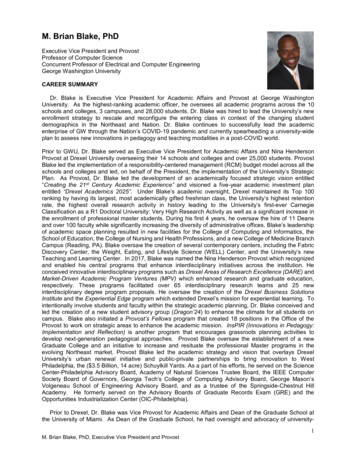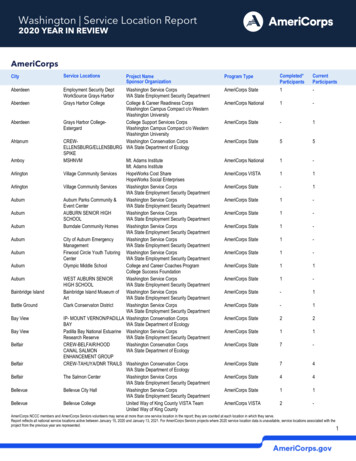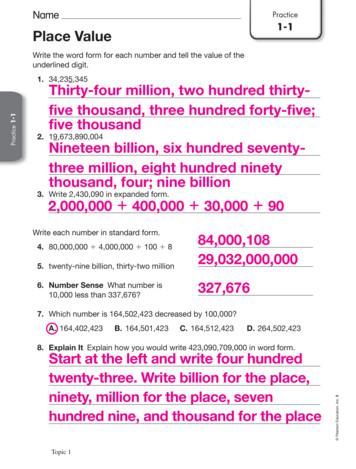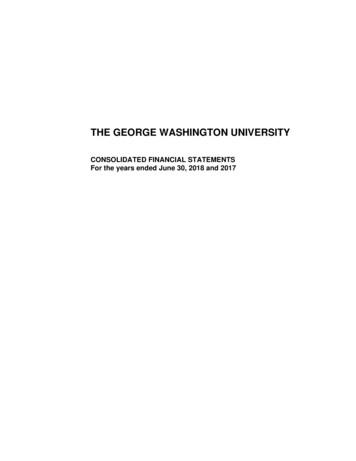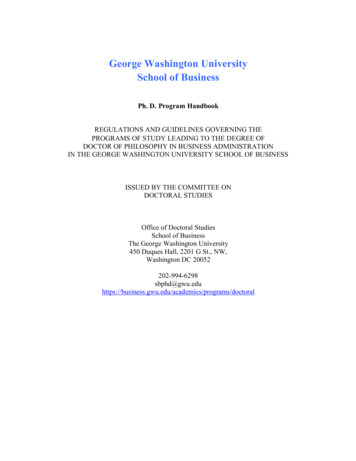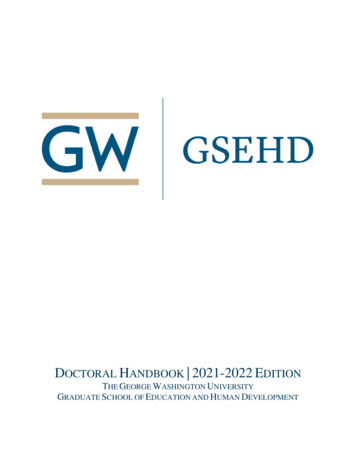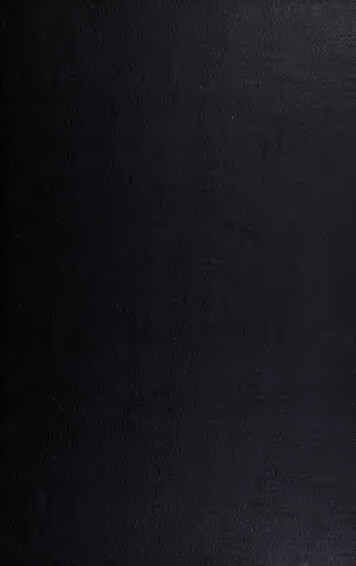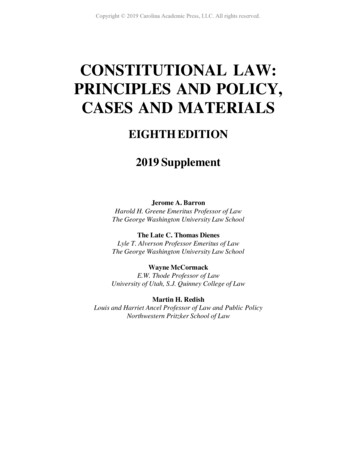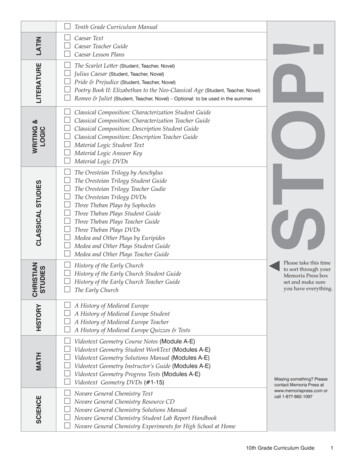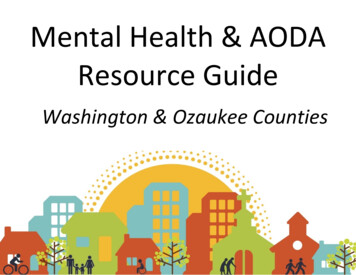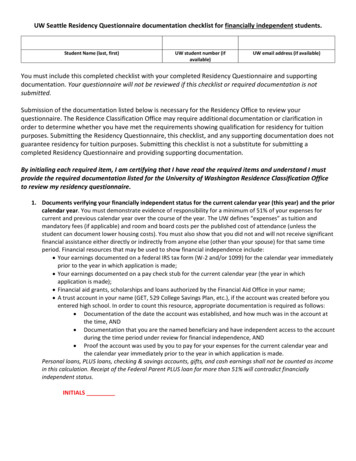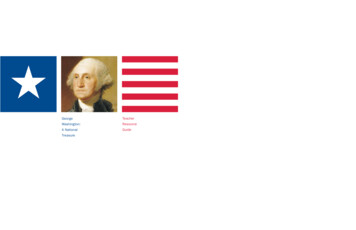
Transcription
GeorgeTeacherWashington:ResourceA NationalGuideTreasure
To the TeacherContents2Student Introductory Reading MaterialAbout George WashingtonThis Teacher Resource Guide is designed2for incorporation into history and socialStudent IntroductoryReading Materialstudies curricula. It will introduce yourstudents to some of the events and issues that· About George Washingtonshaped George Washington’s life. The activities· Chronology of George Washington’s Lifeshould enhance your students’ knowledge ofWashington and expand their horizons of thisActivities and Lesson Planscomplex and interesting man. Please choose the5lessons and activities that best suit the level ofyour students. Adapt them if necessary. Each activityLooking at a National Treasure: George Washingtonby Gilbert Stuart (includes student worksheet andbackground information) includes suggested objectives, procedures, relatedstandards in historical thinking, worksheets, and10 The Right Stuff: What Qualified George Washingtonto Be President (includes student worksheet) other supplemental materials. The level of difficultyfor each activity is indicated with a key: elementary(second grade and above), middle, and upper.12 Picturing George: A Pictorial Survey of the Life ofGeorge Washington The lessons meet United States History Standardsfor either Era 2, Colonization and Settlement, or Era 3,Revolution and the New Nation. The complete13 For Lands’ Sake: George Washington as LandSurveyor (includes student worksheet andbackground information) United States Histor y Standards can be found atwww.sscnet.ucla.edu/nchs/standards. Pleasenote that in the primary source material, the spelling16 In His Own Words: Quotation Timeline (includesstudent worksheet) has been retained from the eighteenth century inmost cases. A selection of online and print sourcesof information about George Washington is included19 Giving Speeches: George Washington’s First andSecond Inaugural Addresses (includes studentworksheet) at the end of this guide. We hope these materialswill enrich your students’ study of George Washingtonand provide them with a deeper appreciation for hisrole in American history.23 Of Human Bondage: George Washington and theIssue of Slavery (includes student worksheet) Written by Susan Silverstein Scott26 Hidden George Washington: Word Search with aTwist (includes student worksheet) Funding for these educational materialsis made possible through the generosityof the Donald W. Reynolds Foundation.National Portrait Gallery, Smithsonian Institution291For Further Research:Resources, Outside Reading,and Websiteseorge Washington was an extraordinaryperson living in extraordinary times. Hisleadership, determination, and ambition helpedhim succeed throughout his life. More than anyone else,Washington proved to be the person who could hold thecountry together at a time when it was new and its futurewas uncertain.GWashington was an effective and well-respected President.Under his leadership, the country remained stable andbalanced. Basic systems of government were established,and Washington kept the country out of conflicts withother nations. As our first President, he served two termsand could have been reelected to a third. But he decidedthat it was in the best interest of the country for him to retire.Washington grew up in Virginia, the third son of a planter.Although his formal education lasted only a few years,he taught himself the skills he needed by watching othersand reading books. The hardworking Washington learnedplanting and land surveying. He was very tall—over sixfeet—and very strong. He loved horseback riding, fox hunting, dancing, and card playing. In he married MarthaDandridge Custis, a widow with large land holdings andnumerous slaves.Washington spent the last few years of his life overseeinghis land and slaves. He was also visited by a steady streamof well-wishers. Six months before he died, he wrote hiswill. A slave-owner all his adult life, Washington felt tornabout the issue of slavery. Although he did not speak publicly about the need to end it, he expressed his opinions inprivate. In his will, he freed his personal servant, WilliamLee, immediately, and the other slaves when his wife,Martha, died. He was the only founding father to do so.While still young, Washington began to devote moreand more time to being a soldier and a politician. Hecommanded forces in the French and Indian War and theAmerican Revolution. His leadership, courage, and braveryinspired the men he commanded. More than once, herode into the thick of battle and emerged unharmedfrom enemy fire. As a young soldier, he was not alwayssuccessful, but he learned from his mistakes.As commander in chief of the Continental army during theAmerican Revolution, Washington faced many challenges.He needed to form and train an army that could do battlewith the mighty British empire. He also faced shortages oftroops, food, and supplies. In spite of these obstacles,Washington persevered. As time went on, his understanding of military strategy deepened. By the war’s end in ,he was the most respected and popular man in the countryand one of the best-known in the world.After the war, Washington resigned his commission in thearmy and returned home to Mount Vernon. Soon he wasback in public service. He was the unanimous choice forpresident of the Constitutional Convention, which wouldcreate the Constitution and the new government. In and , he was the country’s unanimous choice forPresident of the United States. He was so popular thathe might have been chosen king, but he refused.2National Portrait Gallery, Smithsonian Institution
In November, British forces occupy New YorkCity as Washington and his army retreat intoNew Jersey.Chronology ofGeorge Washington’s Life February (February Old Style), Washingtonis born at Popes Creek, Virginia. His family moves to Ferry Farm, nearFredericksburg, Virginia. Washington is appointed surveyor for CulpeperCounty, Virginia. Washington goes to Barbados, West Indies, withhis half-brother Lawrence and contracts smallpox,which leaves him scarred for life. Washington is appointed a major in the Virginiamilitia. Washington carries a message from the governorof Virginia to the French at Fort Le Boeuf nearLake Erie. The message demands that the Frenchwithdraw from the Ohio Valley. They refuse tocomply. Now a lieutenant colonel, Washington leadsan expedition against the French in westernPennsylvania and manages to subdue them. Theincident is said to have sparked the French andIndian War.In a protest against the British tax on tea,Bostonians dump overboard a cargo of tea froma merchant ship. The incident prompts Parliamentto enact stringent measures against Boston.The colonists refer to these measures as theIntolerable Acts. Washington is elected to Virginia’s colonial legislature, the House of Burgesses.The War of Independence begins with the firstarmed resistance to British rule at Lexington andConcord in Massachusetts.The stationing of Washington’s forces atDorchester Heights, overlooking Boston, convinces the British army to evacuate the city.The Continental Congress approves theDeclaration of Independence. The first printedcopies are issued July , .Washington marries Martha Dandridge Custis.National Portrait Gallery, Smithsonian InstitutionIn response to the Intolerable Acts, Washingtonjoins the call in Virginia for the First ContinentalCongress to be convened to protest the heavyhandedness of British rule in the colonies.In December, Washington’s army camps for thewinter at Valley Forge, outside of British-occupiedPhiladelphia. 3 Washington signs legislation calling for placing thenation’s capital on the Potomac River and for policies designed to bolster the country’s fiscal stability. Washington signs an act that creates a nationalbank. He holds his first meetings with his department secretaries, instituting the presidentialcabinet meeting. Washington exercises the presidential veto forthe first time to strike down a congressional bill. Washington is unanimously reelected to thepresidency by the Electoral College. To avoidAmerican involvement in hostilities betweenEngland and France, Washington issues aProclamation of Neutrality. Some criticize himfor not being more sympathetic to the French. Washington authorizes the use of militia tosuppress an uprising over a federal tax on whiskeyin western Pennsylvania. Washington sends the Jay Treaty, an agreementwith Great Britain, to the Senate for ratification.Regarded by many as a sell-out to English interests, the treaty inspires some of the fiercest pressattacks ever made on Washington. In April, Washington sits for Gilbert Stuart’s fulllength Lansdowne painting, commissioned bySenator William Bingham of Philadelphia for theMarquis of Lansdowne.Washington is defeated at the battles ofBrandywine and Germantown.In October, American forces under Horatio Gatesclaim a major triumph at the Battle of Saratoga,a turning point in the war.In June, Washington defeats the British at theBattle of Monmouth.France allies itself with the colonies in the Warof Independence. In October, Washington’s army, with Frenchsupport, defeats the British at the Battle ofYorktown. This ends the military phase of theWar of Independence.Negotiations for peace with Britain are entrustedto John Jay, Benjamin Franklin, John Adams, andHenry Laurens. The Treaty of Paris, making peace between Britainand its former colonies, is signed.Washington resigns his commission as commanderin chief. A convention of delegates from five states meetsat Annapolis and calls for a constitutional convention. Its purpose is to consider altering the Articlesof Confederation, which had governed the countrysince . Washington serves as presiding officer of theConstitutional Convention in Philadelphia.His support for the new Constitution produced bythe convention is a key factor in winning approvalfor it from the requisite nine states.Washington attends the Second ContinentalCongress, which appoints him commanderin chief of the colonies’ newly formedContinental army. – As commander of Virginia troops during theFrench and Indian War, Washington oversees thedefense of his colony’s frontier. Having repealed the Stamp Act, Parliament enactsthe Townshend Duties on various goods shippedto the colonies. This measure inspires angerthroughout the colonies. Washington is unanimously elected by the electoral college to serve as the first President of theUnited States under the Constitution. He is sworninto office April .Executive departments of State, War, and Treasuryare created. Congress passes the Federal JudiciaryAct that organizes the country’s judicial system.In December, Washington crosses the DelawareRiver and defeats British forces at Trenton,New Jersey.The British Parliament passes the Stamp Act,imposing new taxes on its American colonies.The act draws heated objections in the colonies.Though sympathetic to the protest, Washingtonremains uninvolved.Washington helps lead Virginia’s protest againstthe Townshend Duties in the House of Burgesses. As aide-de-camp to British Major General EdwardBraddock, Washington is part of the force defeatedby the French at Fort Duquesne in Pennsylvania.Braddock is killed in the battle. Washington iswidely praised for his calmness and courage in theface of disaster.Washington inherits the , -acre Mount Vernonplantation, which he had rented since . By thetime of his death he expanded it to , acres,with more than , acres under cultivation. Washington is defeated by the French at FortNecessity. He and his men are permitted to returnto Virginia unarmed. In August, Washington suffers defeat at the Battleof Long Island.Student Introductory Reading MaterialWashington announces his intention not to seeka third presidential term. He warns against thedivisiveness of political-party rivalries and thehazards of permanent foreign alliances.4 Washington retires to Mount Vernon. While touring his plantation through rain andsnow in the late fall, Washington contracts athroat infection. Weakened by the purging andbleeding that were common treatments for suchailments, he dies on December .National Portrait Gallery, Smithsonian Institution
Teacher’s Guide I Looking at a National Treasure:George Washington by Gilbert StuartObjectives: . Ask the students to describe any portraits they haveseen or made.· To explain the definition of a portrait· To study the reproduction portrait of George Washingtonby Gilbert Stuart· To identify the visual clues that the artist included inthe portrait· To compare this reproduction portrait to other imagesof Washington· To discuss the importance of portraits as visual recordsand historical documents . Ask the students to think about ways that a portraitserves as a historical document. Ask this questionagain after they have finished studying the portraitof Washington and completing the worksheet. . Display the poster in a prominent place in the room. . Distribute the “Looking at a National Treasure:George Washington by Gilbert Stuart” worksheetand background information to each student.Related standardsin historical thinking:· Chronological thinking: distinguish between past,present, and future time· Historical comprehension: draw upon visual sources· Historical analysis and interpretation: formulate questionsto focus inquiry or analysis; hypothesize the influenceof the past· Historical research capabilities: formulate historicalquestions; obtain historical data; marshal neededknowledge of the time and place to construct a story,explanation, or historical narrative . Allow the students, individually or in small groups,to spend time looking at the portrait of GeorgeWashington. If possible, they should complete theworksheet while looking at the portrait. They shouldread the background information after they havefinished the worksheet. . Have a class discussion to review the students’ answersand observations.Materials: . Ask the students to write a title or caption for theportrait. If appropriate, display their suggestions withthe portrait.· “Looking at a National Treasure: George Washingtonby Gilbert Stuart” student worksheet· “Looking at a National Treasure: George Washingtonby Gilbert Stuart” background information· Poster of the portrait of George Washington byGilbert Stuart (known as the Lansdowne portrait)· Pencils or pens . Ask the students to look for other portraits of GeorgeWashington. They can look at paper and coin currency,newspapers, magazines, books, etc., to find otherimages. If possible, they should bring the images(photocopies or originals) to school. If they cannotbring in the images, they should write descriptionsof them or draw them.Procedures: . Convey the following information about portraitureto the students:a. A portrait is a likeness of a person.b. A portrait can be a painting, photograph,drawing, or sculpture (these are called media).c. Different materials (paint and canvas, pencil,chalk, clay, bronze, camera, and film) canbe used to create a portrait in each medium.d. A portrait gives clues about the sitter’sappearance and character.e. The sitter or the person represented in theportrait does not have to be famous.National Portrait Gallery, Smithsonian Institution2Student Worksheet . Create a classroom display or collage of theWashington portraits. Ask the students to comparetheir images to the Lansdowne portrait. . Have a class discussion about how images of GeorgeWashington are used today in popular culture. Discusswhat characteristics, myths, or virtues we associatewith his image.5Looking at a National Treasure:George Washington by Gilbert Stuartportrait is an image or a likeness of a person.Looking at portraits is one way to learn aboutpeople from the past. A portrait can inform theviewer about the sitter’s appearance as well as the person’scharacter. Many portraits include visual clues that givemore information about the sitter. The background orsetting of a portrait may also reveal something about thesitter’s job, interests, and place (status) in society.2. Does this image portray a man at the beginningof his career or near the end of his career?A Beginning End3. What visual information led you to this conclusion?Spend some time looking at this reproduction of aportrait of George Washington by Gilbert Stuart andthen complete this worksheet. After you have finished,read the background information that follows.4. Does Washington look comfortable with whathe is doing?1. Circlesternthe words you think best describethe way Washington looks in thisportrait. You can add other wordsthat you think are appropriate.happyNoExplain, using your observations.heroicdignifiedwell-dressed5. In what way(s) does the portrait show esidentialenergetic oldpowerfulregalYeshandsome6. What objects do you see that might representthese ccalmformal6National Portrait Gallery, Smithsonian Institution
7. The artist included many interesting objects important to George Washington and the new country. Most ofthe objects are symbols that represent ideas. Look at the clues and draw a line to the appropriate image.13. Which part of this portrait captures your attentionmost? (Circle one)face?handsbody18. Is he wearing a military uniform or civilian clothes?setting of the room19. Are there any significant objects included in theportrait that give you more information or cluesabout him?Why?Same colors as theAmerican flagRepresentation of thenational bird14. Imagine that the artist asked you to pose forthis portrait. Try to position your head, body,feet, and arms in a way that is similar to theportrait. Stand very still. Don’t move. Stand alittle longer! How does it feel? How long do youthink you could hold that position?Representation ofthe calm after thestormy days of theAmerican Revolution20. Compare your answers with your classmates’answers. How many different portraits didyour class think of?Books titled American Revolutionand Constitution & Laws of theUnited States15. Have you seen other images of Washingtonbefore?Washington’s familycoat of arms Yes No21. Explain why you think this painting of GeorgeWashington is considered a national treasure.If yes, which ones?8. Describe what Washington is wearing.10. What would a general wear?22. Are there any schools, roads, buildings, bridges,or monuments in your area named for GeorgeWashington? Make a list of those places. Howmany geographical locations (e.g., states, cities,towns, bodies of water) can you list? If you’restuck, try using an atlas.16. Do they depict Washington as a young man oras an older man?9. Is this outfit appropriate for an American President? Yes 11. What would a king wear?NoWhy or why not?17. Do they depict his whole body or just his head?12. What does George Washington look likehe is about to do?National Portrait Gallery, Smithsonian Institution78National Portrait Gallery, Smithsonian Institution
Teacher’s Guide I Background InformationLooking at a National Treasure:George Washington by Gilbert StuartWashington has one of the most familiar faces in Americanhistory. From his days as the commanding general of thearmy in the American Revolution until long after his deathin , he has been a popular subject for artists. One ofthe most familiar portraits of Washington is on the dollarbill. That portrait is based on another painting by Stuartknown as the “Athenaeum” portrait.Read this after you have completed the worksheet.During his lifetime, George Washington sat for manypainters and sculptors. He did not particularly enjoy sittingfor artists, but he accepted their requests out of a sense ofduty and an appreciation for his role in the country’s history.Gilbert Stuart, one of the most talented portrait paintersin American history, was the artist for this portrait. Itwas arranged and paid for by Senator and Mrs. WilliamBingham of Philadelphia as a gift to the Marquis ofLansdowne, a British admirer of Washington.Since his death, many places have been named forWashington. It is one of the ways his memory has beenkept alive.Objectives: . Before continuing, students should read the introductoryreading material, “About George Washington,” or otherbiographical material about him. Then, in the right-handcolumn of the worksheet, they should put a C forcharacteristic, a Q for qualification, or an S for skill nextto the qualities they think made George Washingtonpresidential material. They may add other words theythink are important.· To create a list of the characteristics, qualifications, andskills that make an effective President of the United States· To determine the characteristics, qualifications, andskills that George Washington had that made him theright choice for President of the United States· To compare and contrast the changing needs for thejob of President of the United StatesRelated standardsin historical thinking: . Compare the lists and ask the students the followingquestions:a. Which qualities did George Washingtonhave that are considered important forany President?b. Did Washington have any characteristics,qualifications, or skills that a modern Presidentdoes not need to have? If yes, which ones?c. What characteristics, qualifications, or skills didWashington not have that you think a modernPresident should have?d. Which characteristics, qualifications, orskills do you consider most important fora President to have? Why?e. Have the qualifications or skills for a Presidentchanged from George Washington’s presidencyto today’s presidency? Discuss those changes.· Chronological thinking: explain change and continuityover timeStuart understood the importance of his subject and wantedto create a portrait for posterity—one whose significancewould last a long time. He thought carefully about themost meaningful way to portray Washington, the leader ofthe country and a symbol of the nation’s great experiment.· Historical research capabilities: formulate historicalquestions; marshal needed knowledge of the time andplace to construct an explanation· Historical analysis and interpretation: formulatequestions; compare and contrast differing sets of ideas,values, personalities, behaviors, and institutionsTo help him depict Washington’s face more accurately,Stuart asked the President to sit for him. Although tiredof sitting for artists, Washington agreed. Stuart thencompleted the rest of the painting without Washingtonpresent. Later on, he asked someone else to stand in forWashington so he could add the body.Materials:· Chalkboard, chalk, and pencils· “The Right Stuff: Characteristics of a President”student worksheet· “About George Washington” student introductoryreading material· Additional biographical information about GeorgeWashingtonStuart painted Washington wearing clothes typical of aneighteenth-century gentleman. The black velvet suit is agood clue that this man is a civilian President, not a kingor a military ruler. As President, Washington wore blackvelvet on official occasions. This is the first full-lengthportrait painted of Washington as head of the government,wearing civilian clothes instead of his military uniform. . Ask the students to choose one characteristic, qualification, or skill from the George Washington column.Through research, they should find examples of howGeorge Washington possessed that characteristic,qualification, or skill. Ask them to present the information to the class.Procedures: . Brainstorm with your students about the qualifications,characteristics, and skills of an effective President. . Ask the students to read the list on the worksheet, entitled“The Right Stuff: Characteristics of a President.” Explainthat the list includes many different characteristics, qualifications, and skills. In the left-hand column they shouldput a C for characteristic, a Q for qualification, or an Sfor skill, next to the qualities they consider importantfor any President of the United States to have. They mayadd other words they think are important.By the time he sat for this portrait, Washington’s publicand political careers were ending. Many people think helooks as if he is about to give a speech. However, near theend of his second term, when Washington decided not torun for President again, he did not give a speech. Instead,he wrote a farewell address that was published in aPhiladelphia newspaper. It was printed in a newspaper sothat as many Americans as possible could read his reasonfor retiring and his hopes for the country’s future.National Portrait Gallery, Smithsonian InstitutionThe Right Stuff: What QualifiedGeorge Washington to Be PresidentGeorge Washington by Gilbert Stuart, oil on canvas, National Portrait Gallery, Smithsonian Institution; acquired as a gift tothe nation through the generosity of the Donald W. Reynolds Foundation910National Portrait Gallery, Smithsonian Institution
Student Worksheet Teacher’s Guide I The Right Stuff:Characteristics of a PresidentPicturing George: A Pictorial Surveyof the Life of George WashingtonRead the list of characteristics/skills/qualifications in the center column. In the left-hand column, mark thoseitems you think are important for a good President with a C, S, or Q. In the right-hand column, mark thosequalities that you think George Washington had that made him qualified to be President with a C, S, or Q.Any thandsomemilitary experience or allstrongGeorge WashingtonObjectives: . Discuss different aspects of George Washington’slife (jobs he held, his hobbies, important life events,his personal characteristics). Draw a chart on thechalkboard that lists the students’ responses. Use thefollowing list for additional ideas:· childhood at Ferry Farm· copying the “Rules of Civility”· relationship with and influence of hishalf-brother Lawrence, including travelto Barbados· time spent at Mount Vernon· land surveying· farming and tobacco· marriage to Martha· participation in the Virginia militia· French and Indian War· involvement with Virginia politics and theHouse of Burgesses· representing Virginia at the ContinentalCongress· being chosen commander in chief duringthe American Revolution· presidency· retirement· To discuss at least one part of George Washington’s lifeand explain why the event was important in his life· To create a pictorial representation of one aspect ofWashington’s life using one of the following media:mural, collage, picture book, or quiltRelated standardsin historical thinking:· Chronological thinking: distinguish between past,present, and future time· Historical analysis and interpretation: formulatequestions to focus inquiry or analysis; explain causes inanalyzing historical actions; compare different stories abouta historical figure, era, or event· Historical research capabilities: formulate historicalquestions; obtain historical data; interrogate historicaldata; marshal needed knowledge of the time and placeto construct a story, explanation, or historical narrativeMaterials:· Either paints, crayons, and large uniform-sized piecesof paper, or scissors, glue, scraps of felt or fabric, andlarge, uniform pieces of felt or fabric· “About George Washington” student introductoryreading material· Additional biographical information on George Washington . Divide the class into small groups. Either assign or haveeach group select a different aspect of Washington’s lifeand career. Ask the groups to thoroughly research thispart of his life and highlight significant events during theperiod. They should also detail relevant dates or years.understands businessfarmerstrong leaderlawyergood with numbersgood communicatorgood characterProcedures: . Select the art activity that the students will use tocreate a pictorial biography of Washington: mural,collage, picture book, or quilt. . Ask the students to design a pictorial image of the event.They should make preliminary drawings or sketchesof their ideas before committing to the final product. . Depending on the students’ reading abilities, eitherread or ask them to read at least one biographyof Washington. . Allow the students to present their images to the classor share them with other classes.prestigiousotherNational Portrait Gallery, Smithsonian Institution11 . Organize the images in chronological or other thematicorder. Display the students’ work in some way—eitherin the classroom or in a hallway outside the class—sothat other students can view their work.12National Portrait Gallery, Smithsonian Institution
Teacher’s Guide I Background InformationFor Lands’ Sake:George Washington as Land SurveyorFor Lands’ Sake:George Washington as Land SurveyorObjectives:wning land was one of the main ways a personhad wealth and status in eighteenth-centuryVirginia. Washington wanted both. However, inorder to acquire land, Washington first needed money.Land surveying, or determining boundaries of land, offereda good way to earn money while also enabling a personto explore land that might be available for purchase.· To discuss the importance of land ownership and thed. Describe how understanding the wildernesshelped Washington later in lifepurpose of land surveying in the eighteenth century· To read and interpret a transcript of an eighteenth-centuryland survey· To reflect on the significance of George Washington’searly surveying career and how it contributed to hispersonal development· To survey an area of land and create a written or visualdescription of it· To construct a piece of historical fiction (for example,a journal entry, newspaper article, or letter) that demonstrates an understanding of Washingto
and Websites G eorge Washington was an extraordinary person living in extraordinary times. His leadership, determination, and ambition helped him succeed throughout his life. More than anyone else, Washington proved to be the person who could hold the country together at a time when it was new and its future was uncertain.
